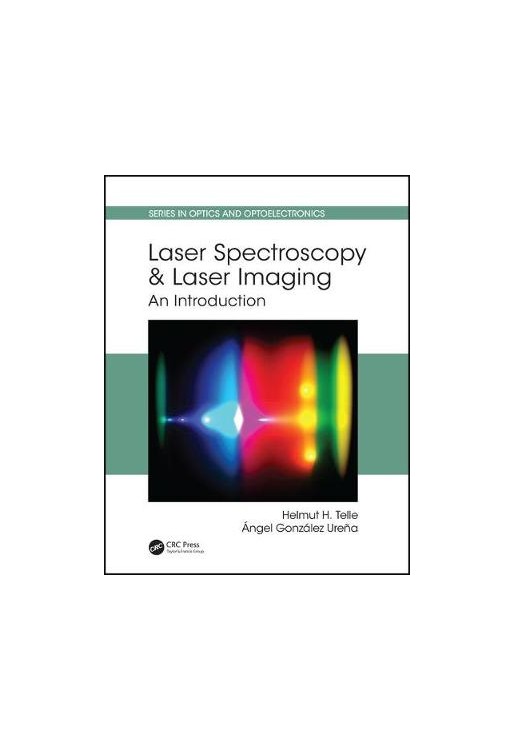Developments in and applications of laser spectroscopy and laser imaging are growing rapidly. This book is a concise collection of laser analysis and imaging techniques, providing a solid overview of the field.
1. Introduction
1.1 Lasers and their impact on spectroscopy and imaging
1.2 The organization of the book
2. The Interaction of Light with Matter
2.1 Absorption and emission of radiation
2.2 Fluorescence and phosphorescence
2.3 Light scattering: elastic processes
2.4 Light scattering: inelastic processes
2.5 Breakthroughs ... and the cutting edge
3. The Basics of Lasers
3.1 The framework for laser action
3.2 Laser cavities: spatial field distributions and laser beams
3.3 Laser cavities: mode frequencies, line shapes and spectra
3.4 Laser cavities: temporal characteristics
3.5 Polarization and coherence properties of lasers and laser beams
3.6 Breakthroughs ... and the cutting edge
4. Laser Sources Based on Gaseous, Liquid or Solid-State Active Media
4.1 Parameters of importance for laser spectroscopy and laser imaging
4.2 Gas laser sources (mostly fixed frequency)
4.3 Dye lasers (tunable frequency)
4.4 Solid-state laser sources (fixed and tunable frequency)
4.5 Fiber laser sources
4.6 Breakthroughs ... and the cutting edge
5. Laser Sources Based on Semiconductor Media and Non-Linear Optic Phenomena
5.1 Semiconductor laser sources
5.2 Quantum cascade lasers
5.3 Laser sources based on non-linear optics - sum and difference frequency conversion
5.4 Laser sources based on non-linear optics - optical parametric Processes (down-conversion)
5.5 Remarks on laser safety
5.6 Breakthroughs ... and the cutting edge
6. Common Spectroscopic and Imaging Detection Techniques
6.1 Spectral and image information and their retrieval
6.2 Photon detection: Single-element devices
6.3 Photon detection: Multi-element array devices
6.4 Charged particle detection
6.5 Detection by indirect phenomena
6.6 Signals, noise and signal recovery methodologies
6.7 Breakthroughs ... and the cutting edge
7. Absorption Spectroscopy and its Implementation
7.1 Concepts of linear absorption spectroscopy
7.2 Line broadening and line shapes in absorption spectroscopy
7.3 Non-linear absorption spectroscopy
7.4 Multi-photon absorption processes
7.5 Key parameters and experimental methodologies in absorption spectroscopy
7.6 Breakthroughs ... and the cutting edge
8. Selected Applications of Absorption Spectroscopy
8.1 Basic methodologies based on broadband sources
8.2 Absorption spectroscopy using frequency-combs
8.3 Absorption spectroscopy using tunable diode and quantum-cascade laser sources
8.4 Cavity-enhancement techniques
8.5 THz-spectroscopy
8.6 Photo-acoustic and photo-thermal spectroscopy with lasers
8.7 Breakthroughs ... and the cutting edge
9. Fluorescence Spectroscopy and its Implementation
9.1 Fundamental aspects of the fluorescence emission
9.2 Structure of fluorescence spectra
9.3 Radiative lifetimes and quantum yield
9.4 Quenching, transfer and delay of fluorescence
9.5 Fluorescence polarization and anisotropy
9.6 Single-molecule fluorescence
9.7 Breakthroughs ... and the cutting edge
10. Selected Applications of Laser-Induced Fluorescence Spectroscopy
10.1 LIF measurement instrumentation in spectro-fluorimetry
10.2 Steady-state laser-induced fluorescence spectroscopy
10.3 Time-resolved laser-induced fluorescence spectroscopy
10.4 Laser-induced fluorescence spectroscopy at the small scale
10.5 Breakthroughs ... and the cutting edge
11. Raman Spectroscopy and its Implementation
11.1 Fundamentals of the Raman process: excitation and detection
11.2 The structure of Raman spectra
11.3 Basic experimental implementations: key issues on excitation and detection
11.4 Raman spectroscopy and its variants
11.5 Advantages and drawbacks, and comparison to other "vibrational" analysis techniques
11.6 Breakthroughs ... and the cutting edge
12. Linear Raman Spectroscopy
12.1 The framework for qualitative and quantitative Raman spectroscopy
12.2 Measuring molecular properties using linear Raman spectroscopy
12.3 Raman spectroscopy of gaseous samples
12.4 Raman spectroscopy of liquid samples
12.5 Raman spectroscopy of solid samples
12.6 Breakthroughs ... and the cutting edge
13. Enhancement Techniques in Raman Spectroscopy
13.1 Waveguide-enhanced Raman spectroscopy
13.2 Cavity-enhanced Raman spectroscopy - CERS
13.3 Resonance Raman spectroscopy - RRS
13.4 Breakthroughs ... and the cutting edge
14. Non-Linear Raman Spectroscopy
14.1 Basic concepts for non-linear Raman spectroscopy
14.2 Surface-enhanced Raman spectroscopy - SERS
14.3 Toward ultra-low concentration and ultra-high spatial resolution Raman spectroscopy - SLIPSERS and TERS
14.4 Hyper-Raman spectroscopy - HRS
14.5 Stimulated Raman spectroscopy - SRS
14.6 Coherent anti-Stokes Raman spectroscopy - CARS
14.7 Breakthroughs ... and the cutting edge
15. Laser-Induced Breakdown Spectroscopy (Libs)
15.1 The method of laser-induced breakdown spectroscopy
15.2 Qualitative and quantitative LIBS analysis
15.3 Selected LIBS applications
15.4 Breakthroughs ... and the cutting edge
16. Laser Ionization Techniques
16.1 Basic concepts of resonance-enhanced multi-photon ionization spectroscopy (REMPI)
16.2 Applications of REMPI in molecular spectroscopy and to molecular interaction processes
16.3 REMPI and analytical chemistry
16.4 Zero electron kinetic energy (ZEKE) spectroscopy
16.5 The technique of H-atom Rydberg tagging
16.6 Breakthroughs ... and the cutting edge
17. Basic Concepts of Laser Imaging
17.1 Concepts of imaging with laser light
17.2 Image generation, image sampling and image reconstruction
17.3 Super-resolution imaging
17.4 Breakthroughs ... and the cutting edge
18. Laser-Induced Fluorescence Imaging
18.1 Planar laser-induced fluorescence imaging (2D- and 3D-PLIF)
18.2 Fluorescence molecular tomography (FMT)
18.3 Super-resolution microscopy
18.4 Super-resolution fluorescence microscopy based on single-molecule imaging
18.5 Breakthroughs ... and the cutting edge
19. Raman Imaging and Microscopy
19.1 Raman microscopic imaging
19.2 Surface-enhanced and tip-enhanced Raman imaging
19.3 Stimulated Raman loss (SRL) imaging
19.4 Coherent anti-Stokes Raman scattering (CARS) imaging
19.5 Breakthroughs ... and the cutting edge
20. Diffuse Optical Imaging
20.1 Basic concepts
20.2 Basic implementation and experimental methodologies
20.3 Modelling of diffuse scattering and image reconstruction
20.4 Clinical applications of diffuse optical imaging and spectroscopy
20.5 Non-clinical applications of diffuse optical imaging and spectroscopy
20.6 Brief comparison with other medical imaging techniques
20.7 Breakthroughs ... and the cutting edge
21. Imaging Based on Absorption and Ion Detection Methods
21.1 Imaging exploiting absorption spectroscopy: From the macro- to the nano-scale
21.2 Imaging exploiting absorption spectroscopy: Selected applications in biology and medicine
21.3 Charged particle imaging: Basic concepts and implementation
21.4 Charged particle imaging: Selected examples for ion and electron imaging
21.5 Breakthroughs ... and the cutting edge


